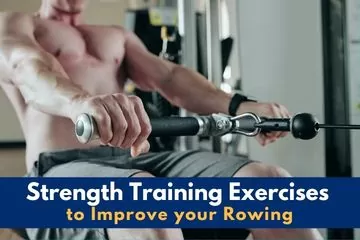
Strength training for rowing is a surprisingly contested topic within the sport. There’s a faction of coaches who believe that the best thing to improve your rowing performance is more rowing. However, I stand firmly on the other side of the fence.
Strength training, when done safely and with good form, will have a huge positive impact on your rowing performance. With good programming, it can fit comfortably in your rowing training and even help you improve your cardiovascular fitness.
The Importance of Strength Training for Rowing Athletes
First, I will discuss the muscles used during the rowing stroke and why you need to strengthen these muscles, and then share with you some of the best rowing-specific strength exercises that you can do.
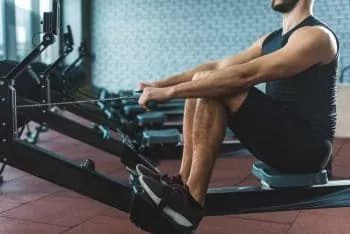
All exercises suggested below are only safe when done with correct form and when you are properly warmed up before going into them. If you don’t know how to perform the exercise correctly, please take the time to research the movement before you race into the gym to try them out! YouTube tutorials are a great resource for this.
To warm up properly, spend some time raising your heart rate and getting your blood pumping at the start of the workout. This could be as simple as spending some time on the stationary rower or bike.
Then start to work through your exercise selection with light weight, practise the movement and the exercise form before beginning to add weight to the bar. I can’t emphasise enough how important it is to warm up before your workout!
Which Muscles Are Used During the Rowing Stroke?
An innocent non-rower would be forgiven for thinking that rowing is mainly an arm workout, but as anyone who’s sat on a rowing machine or in a boat will tell you—it’s so, so much more!
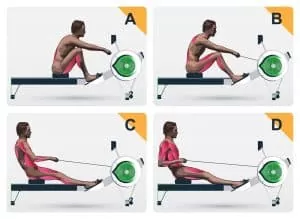
Rowing uses almost all of the major muscles in the body ( you can read more here on muscles worked by rowing ) , which makes it one of the most efficient ways of working out. Of course, we don’t use all of these muscles at the same time during a single stroke.
Over the next couple of paragraphs I will explain which muscle group is used through each part of the rowing stroke.
| Rowing Stroke | Muscle Group Used |
The Catch |
|
The Drive |
|
The Finish |
|
The Recovery |
|
Why Strength Training for Rowing Is Important
From the above section, it is quite clear that you use almost all major muscles groups whenever you row. Strength training offers many benefits, but to rowing athletes, it is crucial for the following reasons:
To Improve Rowing Performance
It follows that if you want to improve your rowing performance, you can make big gains by getting all of these muscles stronger.
To Prevent Injury
Strength training is also crucial for injury prevention. When I first started rowing, I had only ever run and played football before, so I wasn’t particularly strong! After a few months of hammering various rowing workouts, I found that I was picking up all sorts of injuries. In particular, I’d developed an inflamed tendon caused by having slightly weak arms!
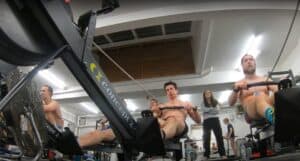
I took a step back and realised that to keep going in rowing, I had to get stronger muscles. People with more muscle mass will be more resilient through the rowing season.
So if you’re looking to get the most of your rowing workout, it’s important that you consider strength training for rowing!
Strength Training Exercises for Rowers
Now, let’s talk about the exercises you can do to strengthen the muscles you use during rowing.
Squats & Weight Training for Rowers to Strengthen Leg Muscles
As we all know: strong legs are hugely important in rowing!
I’m going to simplify the legs into three main muscle groups: the quadriceps (aka quads, the muscles that make up your thighs); the glutes (the muscles that make up your bottom), and the hamstrings (the muscles that are on the back of your thighs).
Quadriceps and Glutes
For me, the very best exercise for both quads and glutes are squats. The best thing about squats is that you really don’t need anything to do them with! If you don’t have access to a gym, there’s no need for fancy barbells and weight plates (although these are fantastic additions which become increasingly useful as you get stronger). You can start squatting with no equipment at all and get stronger by doing more squats or squatting for longer durations.
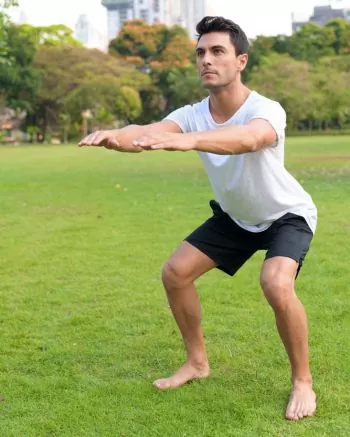
Whilst I was at university, I spent a year coaching a novice men’s team, and we’d regularly go out to the local park, set up a metronome app and squat along to the clicks. We started off by doing 24 squats per minute for 3 minutes, 5 times, and gradually increased this until we were able to squat for 2 sets of 20 minutes of continuous squats!
Of course, this is taking it massively to the extreme. We spent a lot of time building our strength and endurance up across a season to reach this point, so don’t just dive straight into 2×20’s!
For beginners with no equipment, I’d recommend starting off with a 4 sets of 15 squats. Make sure that you are performing these with the best form you can.
Taking the time to learn the correct form is massively important across all of the lifts that I will speak about. If you are not using the correct form, not only are you putting yourself at risk of injury, but you are also not going to get the full benefit from the movement.
Please remember that if something you’re doing is feeling physically painful to your joints, you should stop and seek some advice on your form/mobility from a professional. FYI: Read my full article on the best exercises for rowers to improve mobility
Squat as deep as you comfortably can. For some people this could be so that your hamstrings touch your calves. For others, this might be to get the tops of your thighs parallel to the ground —or even slightly above parallel.
The right depth for the squat is the depth you can comfortably do with your current state of mobility. That said, if you can’t comfortably squat to parallel at the moment, I would recommend spending some time to stretch your hips and posterior chain muscles so that you develop the flexibility do be able to do so. This will really help your rowing performance, too!
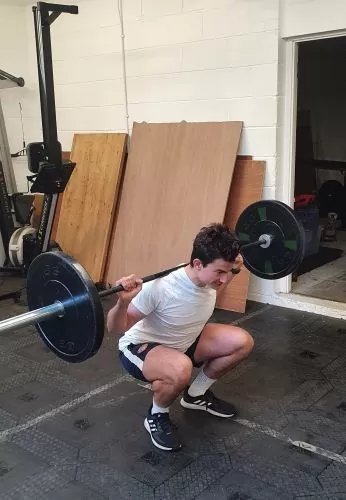
This is me doing squats as part of my weight training
If you have access to weights, you can use a barbell across your back to add weight to your squats. To develop your strength in the squat, use the small 1.25kg plates that your gym will most likely have to add 2.5kg to the bar each day you come into the gym to squat. You’ll soon see your strength skyrocket!
Aside from squats, if you have access to a leg extension machine, these are fantastic for building endurance in the leg muscles—especially for rowers.
I tend to use a slightly lighter weight and higher number of repetitions in order to really fill my quads with lactic acid and see how long I can push through the burning sensation! The power endurance you’ll build from sets of these will really help you during those hard rowing workouts.
Hamstrings
Many rowers often abuse their hamstrings. As these muscles don’t add anything to the drive and power production in the rowing movement, many rowers ignore them and not train them. This is a huge mistake!
Hamstring strength allows you to control the recovery portion of the stroke a lot better (learn more on how to master good strokes per minute rowing). which will ultimately allow you to get into a better position at the catch, get a good connection at the front end of your drive and allow you to take more powerful strokes!
Training your hamstrings is also said to reduce the amount of back pain you may suffer as a rower, as it adds more balance to your muscle structure around your legs.
In my opinion, the very best exercise to improve your hamstring strength is the Romanian deadlift.
The Romanian deadlift, is where you hold a barbell in the top of a deadlift position, use a hip hinge (with softly bent knees) to lean forwards, and lower the bar towards the ground. Using your posterior chain of muscles, you then squeeze the bar back upwards into the top position.
A slight word of warning—I’m always left really feeling it for a couple of days after a good few sets of Romanian deadlifts!
Another benefit of the Romanian deadlift is that it really helps to support you in developing a good hip hinge movement. The hip hinge provides a lot of power in rowing, so ultimately this simple exercise will help you drop those split times!
Deadlift to Strengthen All Rowing Muscles
I couldn’t decide which muscle group to place the deadlift in, so I’m giving it a section of its own. I’m also not going to dwell too much on proper technique for the deadlift, as this is something that I urge you to research thoroughly before attempting.
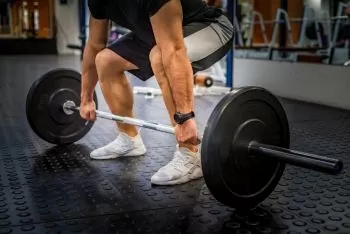
The injury risk is low with proper technique but becomes very high with poor technique. So, please take the time to go onto YouTube and watch some videos on this movement before attempting it. (Disclaimer over!)
Hopefully the above paragraph hasn’t put you off the deadlift because, in my opinion, the movement is truly the king for developing rowing strength and should have its place in every strength training program.
The movement uses all of the muscles that are used in the rowing stroke, so it follows that if you’re able to improve your deadlift power, you’re going to improve your rowing strength. It is a full body movement, and a few sets of deadlifts really gives you a total body workout.
Just like the squat, nail down proper form first, and then move onto adding a small amount of weight each time you return to the gym. The barbell deadlift really is the king to improving your sports performance!
Pull Ups for the Lats and Back
Pull ups are often referred to as the best of the back exercises, and I’d have to agree! They’re one of the most accessible exercises as you don’t need to be in the weight room to perform them, and they don’t cost much to buy. Chances are that your local park will have somewhere suitable for you to do them.
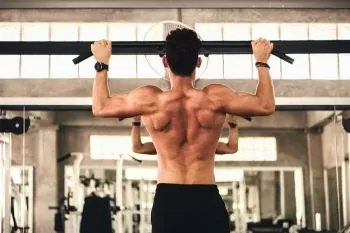
They’re also a really simple exercise to perform and will definitely help you to row faster. Simply hang from a bar and pull yourself up so that your chin comes above the bar. For some people, it may take a long period of training before they have developed the strength to be able to do this, but there are many ways to build strength up to this level.
My favourite way to build pull-up strength is to start by using some resistance band. Loop a band around the bar and place one leg (or knee) into the hanging loop—use this to support you when doing the pull ups. Gradually work your way down to using a lighter and lighter resistance level band, until you can do them without a band at all!
To make pull-ups harder, you can try using a weighted vest or simply holding a dumbbell between your feet.
Pull-ups, although one of the most basic exercises, are a great exercise, as they use most of the muscles across your back. All of these muscles are used in rowing, so this will not only make you stronger but also help with injury prevention as the season goes on.
Core Strength Training
As mentioned above, the core is used throughout the rowing stroke. Your core allows you to hang off the handle through the drive phase of the stroke, and maintain a strong finish position at the end of the stroke.
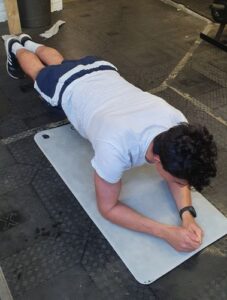
I do the plank as part of my rowing and strength workout
The best advice I’ve received for training core is to do one minute of core strength exercise for every minute you expect to spend racing in the summer—so somewhere between 6 and 8 minutes for most people.
There’s tonnes of core exercises to choose from, so I’ve made a list below of some of my favourites. Choose 9 and work through them 45 seconds on 15 seconds off. Try to choose a mix of rotational, leg raising, upper body raising, and hold exercises.
Good Core Exercises
- Sit up
- Russian twists (using a medicine/stability ball)
- Plank
- Side plank (left and right)
- V-sit ups
- V-sit holds
- Mountain Climbers
- Super Mans
- Scullers
- Bird Dog
- Thread the needle
- Weighted sit ups
- Hanging leg raises
- Leg raises
- Ab crunches
- Swimmers legs
- Figures of eight
- Dead bug
- One arm plank
- Kettlebell swings
Weight Training for Less Used Muscles
So what about those muscles less used in rowing? These are predominantly those of the upper body, namely, the chest (pectoral), shoulder (deltoid), and the muscles in your arms (mainly the triceps as the biceps are used in the back end of the drive). Is training these muscles as important as the rest of the body?
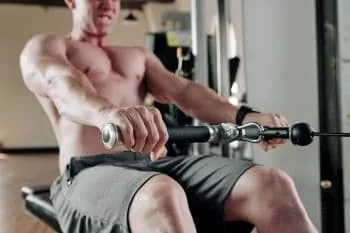
Absolutely!
Training the muscles that you don’t tend to use during your rowing training will help maintain muscle symmetry across your body, and this is very important from the perspective of injury prevention.
This is especially true given the fact that we—rowing athletes—limit ourselves to one plane of motion. Training the muscles we use less and avoiding major muscle imbalances will help to keep our bodies healthy long into later life.
Chest
Training your chest through exercises such as the bench press has major benefits for your rib cage health. Many experienced rowers will tell you that an all too common injury in rowing is the rib stress fracture.
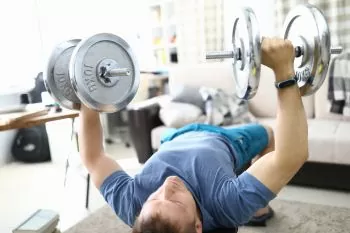
Although it’s impossible to reduce injury risk to 0%, being stronger in the chest will definitely help you stay injury-free for longer.
An alternative to the bench press is the humble push-up. If these are too easy, try using a weighted vest or balancing some books on your back to make the load you’re pushing slightly heavier. Side Note: You might also like to read my other article – What is Good Cross-training for rowers
Shoulders
Shoulders, much like the chest, are also important to train with injury prevention in mind. The Overhead press is a fantastic movement for doing so, and it’s the exercise that always makes me feel like a strongman doing!
Concluding Thoughts
For a rowing athlete, weight training is hugely important to building strength and resilience. It will help you drop seconds off of your split times, and it works wonders for injury prevention.
Everyone who spends time on the rowing machine, at any fitness level, should take the time to include strength training exercises in their training programme.
Written by Max Secunda – RowingCrazy.com
Experienced Heavy Weight Rower, Rowing Instructor & Coach, Novice Men’s Rowing Captain, British Concept 2 Record Holder & Rowing YouTube Influencer
Max is a rower at Vesta Rowing Club based in London, UK. He started rowing at the University of Sheffield, where he also was the Captain of the Novice Men’s Rowing Team, Max has a well know YouTube channel where he vlogs about his rowing training and experiences.



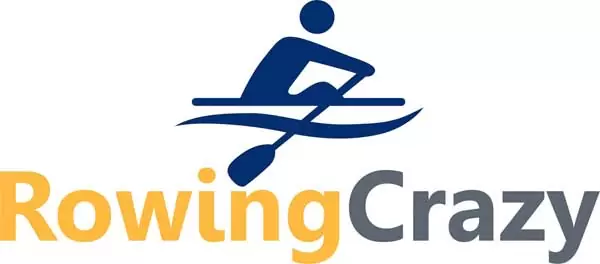


Pingback: Best Rowing Machine for Back Pain - Our Top Picks
Pingback: How to Improve Rowing Split Time & Power Up Your Stroke!
Pingback: Why Are Rowers Such Good Cyclists?| Rowing Crazy